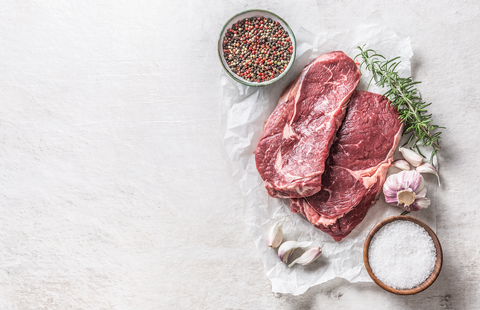For several years now, beef has had a bad reputation, whether for health or ecological reasons, many meat eaters have swapped beef for tofu. With the lack of transparency in the food industry, it is quite normal that we ask more questions about the production and breeding practices of what is on our plates. This new interest that consumers have in their diet is one of the main reasons behind the multiple types of meat that we now find in supermarkets, at our butchers and even in fast food chains. In fact, there are organic meats, raised without hormones, raised without antibiotics and more recently, meat from grass-fed animals.
What is grass-fed beef?
Grass-fed beef is a relatively new product on the shelves and still unknown to the consumer. Currently, they are found in specialized health grocery stores, but not in conventional supermarkets. The “grass-fed” claim may differ slightly from farm to farm, but in general it indicates that the animal in question has been grass-fed, i.e. pasture-fed, for the longest time. possible and that in winter, or when weather conditions are extreme, it is fed with hay. The final fat, protein, vitamin and mineral composition of grass-fed beef is greatly influenced by the diet of the animal in question. So let's see how a grass-fed diet influences the final nutrient composition of beef and its taste.
A different nutritional facts table
Is this meat more interesting from a nutritional point of view? Yes! The first difference that we can observe is that grass-fed beef is less fat, and therefore less caloric, than conventional meat. In fact, grass is a low-calorie food and the animal must work hard to chew it. Ruminating is a term associated with ruminants (e.g. cattle, sheep and goats) which regurgitate their food in order to chew it again. This therefore requires a lot of energy from the animal. The type of fat found in grass-fed beef is also different. Firstly, the color of the fat is modified by certain pigments present in the grass such as carotenoids for example. These pigments, having great antioxidant power, therefore make the fat more yellow. Second, the quality of fat is also different. In fact, studies have shown that grass-fed beef has more omega-3 and that its omega-6/omega-3 ratio is more balanced. Where does the importance of this ratio come from? Well, omega-3 and omega-6 are fatty acids considered essential since our body cannot synthesize them. It is therefore important to consume foods that are composed of them. However, when the ratio of omega-6 and omega-3 is unbalanced, the benefits can be reversed and our cardiovascular health can suffer, hence the importance of a more stable ratio. Grass-fed beef also has more precursors, molecules involved in the synthesis of other molecules, vitamin A and E, than conventional meat. Additionally, this meat would have more vitamin B12, a vitamin that contributes to many, many, many important body metabolisms.
What about the taste?
It differs from person to person. Some like it, some don't. You will guess that the Local Reserve team loves it! As grass affects the nutritional value of the meat, it also affects the taste of the meat. The meat is more flavorful, the taste also changes with the seasons and the grass makes it less uniform from one piece of meat to another and from one animal to another.
Several environmental benefits have also been demonstrated in the past and some Quebec farms even claim to produce carbon-neutral meat thanks to their grass-fed beef. Grass-fed beef from Quebec is therefore a great way to reduce your ecological footprint, benefit from different nutritional benefits, discover a new product and encourage local producers.
If you want to know more about the concept, the Réserve Locale team encourages you to watch the Radio-Canada report for the program La Semaine Verte, cited below.
To discover our grass-fed beef products, click here !
Sources used for writing this article:
Bérubé, S. (2016). Grass-fed beef, an underrated specialty . Spotted at https://plus.lapresse.ca/screens/aca1eda3-282c-4f32-9b9a-3b8c26925ca5__7C___0.html .
Daley, C. et al. (2010). A review of fatty acids profiles and antioxidant content in grass-fed and grain-fed beef. Retrieved from https://www.ncbi.nlm.nih.gov/pmc/articles/PMC2846864/ .
Leheska, J.M. (2008). Effects of conventional and grass-feeding systems on the nutrient composition of beef. Retrieved from https://pubmed.ncbi.nlm.nih.gov/18641180/ .
Corneau, M. and Marcoux, É. (2020). Carbon neutral beef . Radio-Canada. Retrieved from https://ici.radio-canada.ca/tele/la-nouvelle-verte/site/segments/reportage/211430/boeuf-carboneutre-herbe .






Comments (0)
There are no comments for this article. Be the first to leave a message !